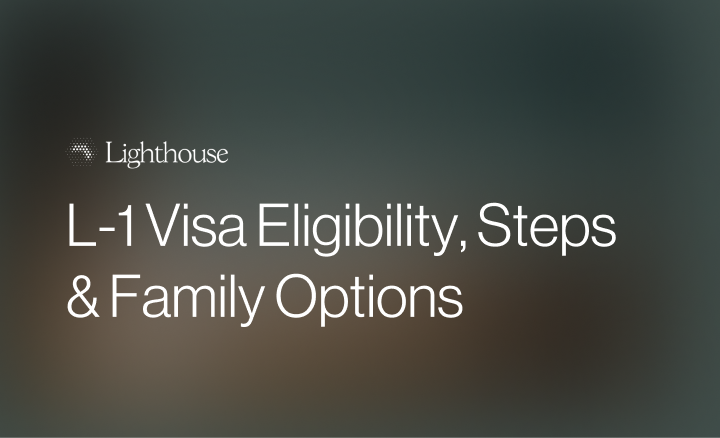Visa Sponsorship Explained
Everything you need to know about visa sponsorship for supporting a foreign national’s U.S. immigration process.


Visa sponsorship is the legal process where a qualified individual or organization in the United States supports a foreign national's visa application to USCIS (U.S. Citizenship and Immigration Services). The sponsor provides necessary documentation, meets specific requirements, and often accepts financial responsibilities to help the foreign national obtain legal status to live, work, or study in the United States.
What is visa sponsorship?
Visa sponsorship is a legal mechanism under U.S. immigration law where a qualifying individual, employer, or organization takes responsibility for supporting a foreign national's visa application. The sponsor commits to specific obligations throughout the immigration process and sometimes beyond.
The sponsor serves as the bridge between the foreign national (called the beneficiary) and U.S. immigration authorities. They file petitions, provide documentation, and affirm that the beneficiary meets eligibility requirements. Without sponsorship, most foreign nationals cannot obtain work authorization or permanent residence in the United States.
This sponsorship system exists for two primary reasons: to ensure foreign nationals have financial support and won't become public charges, and to verify that employment-based immigration fills genuine workforce needs without displacing U.S. workers. The sponsor essentially vouches for the beneficiary and accepts legal accountability for certain aspects of their stay.
Who can provide visa sponsorship
Employers
U.S. employers can sponsor foreign workers for temporary or permanent employment-based visas. This includes both nonimmigrant visas, such as the H‑1B visa for specialty occupations, and immigrant visas that lead to a green card. Employer sponsorship is common in technology, healthcare, finance, and engineering, where specialized skills are in high demand.
To qualify, the employer must:
- Offer a legitimate, full-time position.
- Demonstrate that the role requires a specific degree or skill set.
- Pay at least the prevailing wage for the occupation and location.
- File the appropriate petition forms with USCIS and, when required, obtain labor certification from the U.S. Department of Labor (DOL).
Family members
U.S. citizens and lawful permanent residents can sponsor certain relatives for immigration. Citizens have broader sponsorship rights than green card holders.
U.S. citizens can sponsor:
- Spouse
- Unmarried children under 21
- Parents (if the sponsor is 21 or older)
- Adult children (married or unmarried)
- Siblings (if the sponsor is 21 or older)
Lawful permanent residents can sponsor:
- Spouse
- Unmarried children of any age
Family sponsors must meet income requirements, typically 125% of federal poverty guidelines, and sign Form I-864, Affidavit of Support. This legally binding contract obligates them to financially support the immigrant if necessary.
Types of visa sponsorship
Employment-based sponsorship
Employment sponsorship covers both temporary (non-immigrant) and permanent (immigrant) pathways.
Temporary work visas require employers to file Form I-129 with USCIS. Most categories need a certified Labor Condition Application from the Department of Labor, confirming the position pays prevailing wages and won't adversely affect U.S. workers. These visas typically allow stays of one to three years with possible extensions.
Permanent residence through employment involves Form I-140 petitions. The EB-2 and EB-3 categories usually require labor certification (PERM), where employers prove no qualified U.S. workers are available. The process confirms the job offer is genuine and the foreign worker won't displace American workers.
Many employment-based visas allow dual intent, meaning you can pursue a green card while maintaining temporary status. This flexibility helps skilled workers plan long-term careers in the United States.
Family-based sponsorship
Family sponsorship begins with Form I-130, establishing the qualifying relationship between sponsor and beneficiary.
Immediate relatives of U.S. citizens (spouses, minor children, parents) have no annual limits and typically process faster. They file for adjustment of status using Form I-485 if already in the U.S., or go through consular processing at a U.S. embassy abroad.
Family preference categories face annual quotas:
- F1: Unmarried adult children of citizens
- F2A: Spouses and minor children of green card holders
- F2B: Unmarried adult children of green card holders
- F3: Married children of citizens
- F4: Siblings of citizens
Wait times vary dramatically by category and country of birth. Some preference categories face backlogs spanning decades. The National Visa Center coordinates document collection once USCIS approves the initial petition.
Eligibility and requirements
For sponsors
Sponsors must meet specific requirements depending on the visa type:
- Be a U.S. citizen, lawful permanent resident, or qualified employer.
- Have sufficient income or assets to support the beneficiary.
- Maintain compliance with immigration and labor regulations.
- For employers, maintain good standing with USCIS and DOL and pay all required fees directly.
For beneficiaries
Beneficiaries must demonstrate eligibility for the visa category:
- Employment-based applicants must meet education or experience standards and hold valid credentials or licenses.
- Family-based applicants must prove a legitimate relationship with the sponsor.
- All applicants must pass background checks and meet admissibility standards, including medical and security screenings.
How to apply for visa sponsorship in the U.S.
Employment-based steps
- Employer determines the appropriate visa category based on job requirements, candidate qualifications, and employer needs. Consider factors like degree requirements, wage levels, and whether the position qualifies for cap-exempt filing.
- Employer obtains labor certification if required. For H-1B and other temporary visas, file a Labor Condition Application with the Department of Labor. For permanent residence (PERM), conduct recruitment to test the labor market.
- Employer files petition with USCIS. Submit Form I-129 for temporary workers or Form I-140 for immigrant workers. Include supporting documents: job offer letter, educational credentials, experience letters, and labor certification.
- USCIS reviews the petition. Standard processing takes several months. Premium processing (15 calendar days) is available for many employment petitions at additional cost.
- Beneficiary applies for visa or adjusts status. If abroad, apply at a U.S. consulate once the petition is approved. If in the U.S., file for adjustment of status or change of nonimmigrant status when eligible.
- Beneficiary begins employment only after receiving work authorization. Maintain compliance with visa conditions throughout employment.
Family-based steps
- Sponsor files Form I-130 with USCIS, establishing the family relationship. Include proof of sponsor's status and evidence of the qualifying relationship.
- Wait for approval and priority date. Immediate relatives can proceed immediately. Preference categories must wait for visa availability based on priority date and annual limits.
- Complete National Visa Center processing. Submit civil documents, financial evidence, and Form I-864 Affidavit of Support. Pay fees and provide required forms.
- Beneficiary attends visa interview at U.S. embassy or consulate (if abroad) or files adjustment of status with Form I-485 (if in the U.S.). Bring originals of all submitted documents.
- Receive immigrant visa or green card. Enter the U.S. within visa validity period or await adjustment approval if already present.
Employer obligations and documentation
Employers accepting visa sponsorship responsibilities must maintain extensive documentation and meet ongoing compliance requirements.
Labor Condition Application: Before filing H-1B petitions, employers certify they'll pay at least the prevailing wage for the occupation and location. They must maintain a Public Access File containing wage documentation, job posting notices, and the certified LCA.
Position verification: Employers provide detailed job descriptions establishing that the role genuinely requires specialized knowledge and a degree in a specific field. They must show the position exists and isn't created solely for immigration purposes.
Wage documentation: Tax returns, quarterly wage reports, and payroll records prove the company's ability to pay the offered salary. The employer must continue paying the promised wage throughout employment, even during benching periods for H-1B workers.
Recordkeeping: Sponsors maintain employee records, I-9 forms, and documentation supporting the original petition. These must be available for government inspection for specified retention periods.
Notification requirements: Employers must inform USCIS about material changes like job termination, significant duty modifications, or worksite changes requiring amended petitions.
Visa sponsorship costs
Costs vary depending on the type of visa and the size of the sponsoring organization.
Employment-based fees
Government fees vary by visa type and employer size. For H-1B petitions, current fees include base filing fees, ACWIA training fees (varying by company size), fraud prevention fees, and additional fees for certain employers. Premium processing adds extra cost for 15-day adjudication. Check the USCIS Fee Calculator for current amounts as fees change periodically.
By law, employers must pay mandatory government fees and cannot pass these costs to workers. Premium processing fees may be paid by either party if voluntary.
Family-based fees
Current family-based petition fees include Form I-130 filing fees, adjustment of status package fees (including biometrics), immigrant visa processing fees, and medical examination costs. The Form I-864 Affidavit of Support itself has no fee. Additional costs include document translations, travel to interviews, and obtaining civil documents. Verify current fees at USCIS.gov.
Total cost considerations
Employment sponsorship often totals several thousand dollars including legal fees, with amounts varying significantly based on visa type and case complexity. Family sponsorship typically costs less but still requires substantial investment. These figures exclude attorney fees, which vary based on case complexity and geographic location.
Supporting documents checklist
Sponsors and beneficiaries should prepare:
Sponsor documentation
- Proof of citizenship or lawful permanent residence
- Business registration and tax identification (employers)
- Tax returns for past three years
- Bank statements and financial records
- Employment verification letter
- Corporate structure documentation (employers)
Beneficiary documentation
- Valid passport
- Educational diplomas and transcripts
- Professional licenses and certifications
- Employment verification letters detailing experience
- Resume or curriculum vitae
- Birth certificates (family-based)
- Marriage certificates (if applicable)
- Police certificates from countries of residence
Petition-specific forms
- Form I-129 with applicable supplements (nonimmigrant workers)
- Form I-130 (family relationships)
- Form I-140 (immigrant workers)
- Form I-485 with supplements (adjustment of status)
- Form DS-160 or DS-260 (visa applications)
- Form I-864 with tax documents (family sponsors)
- Labor certification documentation
Keep copies of everything submitted. Original documents should accompany interview attendance when requested.
Common visa sponsorship jobs and industries
Visa sponsorship jobs are concentrated in industries that rely on specialized knowledge or global collaboration:
- Technology and engineering (software developers, data scientists)
- Healthcare and life sciences (nurses, researchers)
- Finance and consulting (analysts, auditors)
- Education and research (professors, postdoctoral fellows)
- Manufacturing and skilled trades
Many companies that sponsor work visas include major technology firms, universities, and healthcare systems. Positions often require degrees in specialty occupations and full-time employment. Some internships or training programs may qualify under the exchange visitor category.
For comprehensive guidance on specific visa categories, see Lighthouse's resources on the O-1 visa for extraordinary ability or the H-1B visa for specialty occupations.
Processing time and agencies involved
Three federal agencies coordinate visa sponsorship, each with distinct responsibilities and timelines.
USCIS handles petition adjudication. Processing times vary significantly. Premium processing guarantees 15 calendar days for eligible petitions. Regular processing can take several months. Check current times at USCIS Processing Times.
Department of Labor certifies labor conditions and prevailing wages. Labor Condition Applications typically process within seven business days. PERM labor certification can take six months to over a year. Prevailing wage determinations require several months.
Department of State manages visa issuance at embassies and consulates. Interview scheduling varies dramatically by location and visa type. Administrative processing, if required, adds weeks or months. Visa printing and delivery typically takes one to two weeks after approval.
Processing times vary widely. Employment-based petitions may take 15 days with premium processing or several months under standard review. Family-based sponsorship can range from six months for immediate relatives to several years for preference categories, depending on visa availability.
Common mistakes and how to avoid them
Incomplete forms cause most delays. Every question needs an answer. Write "N/A" or "None" rather than leaving blanks. Sign and date where required. Missing signatures trigger automatic rejections.
Incorrect fees result in returned petitions. Fee amounts change periodically. Verify current fees on USCIS.gov immediately before filing. Pay by check or money order from U.S. banks only.
Missing labor documentation undermines employment petitions. File Labor Condition Applications before I-129 submissions. Include certified LCAs with petitions. Maintain Public Access Files from day one.
Misrepresenting relationships or qualifications can bar future immigration benefits. Provide truthful, complete information. Explain discrepancies proactively. Never claim false relationships or credentials.
Deadline violations jeopardize status. File extensions before expiration. Respond to Requests for Evidence within specified timeframes. Calendar all critical dates with reminders.
Important note: Immigration law changes frequently. Verify all requirements directly at USCIS.gov before filing any petition or application.
Recent USCIS updates or policy guidance
USCIS modernization efforts now allow electronic signatures on many forms, reducing paper filing requirements. The agency expanded online filing options for Form I-130 family petitions and certain employment-based applications.
Recent updates affecting visa sponsorship include:
- Expansion of electronic filing and digital signatures for several forms.
- Broader access to premium processing for additional visa categories.
- Updated fee schedule effective January 2024.
- Enhanced online case tracking through USCIS accounts.
The agency continues issuing policy memoranda and updates through its newsroom. Regular monitoring helps sponsors and beneficiaries stay compliant with evolving requirements.
How Lighthouse helps
Visa sponsorship involves multiple agencies, strict documentation, and precise timing. Lighthouse simplifies this process for both employers and candidates. Our platform combines expert case management with technology built for immigration compliance. We help you:
- Evaluate eligibility and identify the right type of visa.
- Prepare and review all required forms and supporting documentation.
- Coordinate filings with USCIS, the Department of Labor, and the Department of State.
- Track case progress and maintain compliance for dependents and renewals.
Lighthouse provides comprehensive support for employer sponsorship and complex petitions involving extraordinary ability or labor certification.
Get started with Lighthouse.
Frequently asked questions
What does a visa sponsorship mean?
Visa sponsorship means a U.S. citizen, permanent resident, or organization agrees to support a foreign national’s visa or green card application. The sponsor provides documentation to USCIS confirming eligibility and accepts legal responsibility for the beneficiary’s compliance with immigration laws.
How do I get a visa sponsorship in the U.S.?
You must secure a qualifying relationship with a U.S. sponsor. For employment-based visas, this means obtaining a job offer from a company willing to file a petition on your behalf. For family-based visas, a U.S. citizen or permanent resident relative must file Form I‑130. Lighthouse helps employers and professionals manage the sponsorship process from eligibility review to petition filing.
Who can be a sponsor for a U.S. visa?
Sponsors can be U.S. employers, citizens, lawful permanent residents, or designated organizations such as universities or nonprofits. Each sponsor must meet specific requirements under immigration laws and demonstrate financial or operational capacity to support the beneficiary.
How to be a sponsor for a visa?
To sponsor someone, you must file the correct petition form with USCIS—Form I‑129 for nonimmigrant workers, Form I‑140 for immigrant workers, or Form I‑130 for family members. You must also provide supporting documentation, pay required fees, and comply with all U.S. sponsorship visa requirements.
What are the costs and timeframes for sponsorship?
Employer sponsorship costs typically range from several hundred to several thousand dollars depending on the visa type and whether premium processing is used. Family sponsorship fees are lower but vary by form and location. Processing times can range from weeks to over a year. You can estimate current fees using the USCIS Fee Calculator.
What jobs offer visa sponsorship in the U.S.?
Common visa sponsorship jobs include roles in technology, healthcare, finance, education, and engineering. Many companies in New York, California, and other major hubs regularly sponsor foreign workers for employment-based visas. Lighthouse assists both employers and skilled workers in identifying the right visa options and preparing compliant applications.
Lighthouse provides expert guidance and legal review to strengthen your case.
From document prep to USCIS submission, Lighthouse ensures your petition meets every requirement.

%201.svg)



